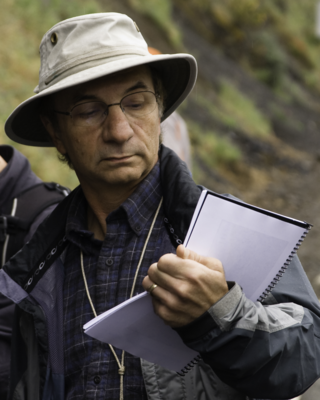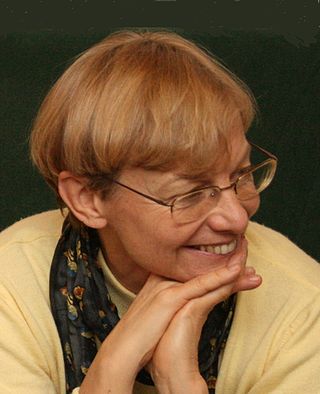
John Norris Bahcall was an American astrophysicist and the Richard Black Professor for Astrophysics at the Institute for Advanced Study. He was known for a wide range of contributions to solar, galactic and extragalactic astrophysics, including the solar neutrino problem, the development of the Hubble Space Telescope and for his leadership and development of the Institute for Advanced Study in Princeton.
George Wetherill was a physicist and geologist and the director emeritus of the department of terrestrial magnetism at the Carnegie Institution of Washington, DC, US.
Christopher Thomas Russell is head of the Space Physics Center at the Institute of Geophysics and Planetary Physics (IGPP) at UCLA, professor in UCLA's Department of Earth, Planetary, and Space Sciences, and Director of the UCLA Branch of the California Space Grant Consortium. He received a B.Sc. from the University of Toronto in 1964 and a Ph.D. from UCLA in 1968. In 1977 he was awarded the James B. Macelwane Medal and in 2003 the John Adam Fleming Medal by the American Geophysical Union (AGU). He is also a Fellow of the AGU. Asteroid 21459 Chrisrussell was named after him in 2008. In 2017, he was awarded the NASA Distinguished Public Service Medal. He has three grandchildren.

Don Lynn Anderson was an American geophysicist who made significant contributions to the understanding of the origin, evolution, structure, and composition of Earth and other planets. An expert in numerous scientific disciplines, Anderson's work combined seismology, solid state physics, geochemistry and petrology to explain how the Earth works. Anderson was best known for his contributions to the understanding of the Earth's deep interior, and more recently, for the plate theory hypothesis that hotspots are the product of plate tectonics rather than narrow plumes emanating from the deep Earth. Anderson was Professor (Emeritus) of Geophysics in the Division of Geological and Planetary Sciences at the California Institute of Technology (Caltech). He received numerous awards from geophysical, geological and astronomical societies. In 1998 he was awarded the Crafoord Prize by the Royal Swedish Academy of Sciences along with Adam Dziewonski. Later that year, Anderson received the National Medal of Science. He held honorary doctorates from Rensselaer Polytechnic Institute and the University of Paris (Sorbonne), and served on numerous university advisory committees, including those at Harvard, Princeton, Yale, University of Chicago, Stanford, University of Paris, Purdue University, and Rice University. Anderson's wide-ranging research resulted in hundreds of published papers in the fields of planetary science, seismology, mineral physics, petrology, geochemistry, tectonics and the philosophy of science.

Sidney David Drell was an American theoretical physicist and arms control expert.
Nelson Woolf Polsby was an American political scientist. He specialized in the study of the United States presidency, the United States Congress and how governmental policies and practices evolve.
Alastair G. W. Cameron was an American–Canadian astrophysicist and space scientist who was an eminent staff member of the Astronomy department of Harvard University. He was one of the founders of the field of nuclear astrophysics, advanced the theory that the Moon was created by the giant impact of a Mars-sized object with the early Earth, and was an early adopter of computer technology in astrophysics.
The James B. Macelwane Medal is awarded annually by the American Geophysical Union to three to five early career scientists. It is named after James B. Macelwane, a Jesuit priest and one of the pioneers of seismology. The medal is regarded as the highest honor for young scientists in the field of Geological and Planetary Sciences. In 1984, Mary Hudson became the first woman to receive the award.

Annual Review of Earth and Planetary Sciences is an annual peer-reviewed scientific journal published by Annual Reviews, which broadly covers Earth and planetary sciences, including geology, atmospheric sciences, climate, geophysics, environmental science, geological hazards, geodynamics, planet formation, and solar system origins. The co-editors are Katherine H. Freeman and Raymond Jeanloz. As of 2023, Journal Citation Reports gives the journal a 2022 impact factor of 14.9. As of 2023, it is being published as open access, under the Subscribe to Open model.
Vassilis Angelopoulos is a Greek American physicist. He is a specialist on space and astrophysical plasmas.

Inez Fung is a professor of atmospheric science at the University of California, Berkeley, jointly appointed in the department of earth and planetary science and the department of environmental science, policy and management. She is also the co-director of the Berkeley Institute of the Environment.
Wen Lianxing is a Chinese seismologist and geophysicist. He is a professor at Stony Brook University and the University of Science and Technology of China. He was awarded the James B. Macelwane Medal in 2003 and elected a fellow of the American Geophysical Union.
Wick C. Haxton is an American theoretical nuclear physicist and astrophysicist. He is a professor of physics at the University of California, Berkeley and senior faculty scientist at Lawrence Berkeley National Laboratory. He was appointed a co-editor of the journal Annual Review of Nuclear and Particle Science as of 2023.

Donald James DePaolo is an American professor of geochemistry in the department of earth and planetary science at the University of California, Berkeley and associate laboratory director for energy and environmental sciences at the Lawrence Berkeley National Laboratory.
Katherine H. Freeman is the Evan Pugh University Professor of Geosciences at Pennsylvania State University and a co-editor of the peer-reviewed scientific journal, Annual Review of Earth and Planetary Sciences. Her research interests are organic geochemistry, isotopic biogeochemistry, paleoclimate and astrobiology.

Alexander J. Dessler was an American space scientist known for conceiving the term heliosphere and for founding the first Space Science Department in the United States.

Barbara A. Romanowicz is a French geophysicist and an expert on imaging the Earth's interior.

Colette L. Heald is a Canadian-born professor at the Massachusetts Institute of Technology (MIT) who is an expert in atmospheric chemistry.
Vincent H. Resh is an American entomologist who primarily researches aquatic insects and medical entomology. He was the co-editor of the Annual Review of Entomology from 1991 to 1997.
Thorne Lay is an American seismologist. He was born in Casper, Wyoming in 1956, and raised in El Paso, Texas. He is a professor of earth and planetary sciences at the University of California, Santa Cruz.









